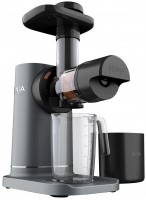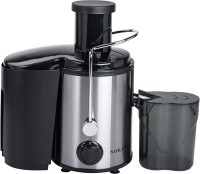How to choose juicer
We independently test the products and technologies that we recommend.

Types of juicers
First of all, before purchasing, you need to decide on the type of juicer, since key indicators such as:
- flow Rate;
- types of processed products;
- cooking speed;
- juice shelf life.
The modern market of household appliances offers the following types of juicers:
For citrus fruits
These are simple, fairly compact and inexpensive devices for processing only citrus fruits: oranges, grapefruits, lemons, limes, etc. They consist of a rotating nozzle with a ribbed surface and a container into which the juice flows. All you have to do is cut the fruit in half and place the half on the attachment, flesh side down. In conventional models, you will have to press it manually, but there are also more advanced devices with a pressing mechanism. Often, citrus juicers have low power and cost, as they are quite simple to equip and use. Perhaps they have only one drawback - they are narrowly focused, because they are intended only for citrus fruits and are not capable of squeezing juice from other fruits.
Centrifugal
These are some of the most popular juicers today as they are versatile and highly efficient. Such models have more complex equipment: the fruits are first crushed, after which a separator separates the juice from the cake. By the way, the cake remains quite moist, so it can be used in other dishes - for example, in pies and other baked goods. However, the amount of pure juice is correspondingly less. When purchasing a juicer, we advise you to pay attention to models with automatic ejection of the squeezed pulp into a separate container. This function greatly simplifies cleaning the device: you do not have to periodically stop the process and clean the separator.
During operation, the engine develops high speed and provides a large number of revolutions, which leads to an increase in temperature. Firstly, the juice can heat up, and secondly, it oxidizes due to contact with air currents. As a result, some of the vitamins are destroyed, and the shelf life of the juice is reduced. To get the maximum nutrients, it is better to drink it immediately, within 10 – 20 minutes after preparation. In addition, due to the high power, the devices are quite noisy, and the juice often comes out with foam.
But centrifugal juicers also have many advantages. They are universal because they can process almost any vegetables, fruits and berries. Although it is difficult for them to cope with fibrous and hard fruits. In addition, such juicers are characterized by high productivity: they work quickly and process a large number of products in a short time. Therefore, they are in demand among home canning enthusiasts and garden owners.
Screw
This type of juicer is similar in principle to a meat grinder: rotating, the auger crushes the fruits and crushes them, and a special sieve retains the pulp, allowing only juice into the container. Manufacturers offer vertical and horizontal models, which differ in the design and location of the auger. In the first case, the ingredients fall under their own weight, in the second, they must be pushed into the neck with a pusher.
The advantage of auger juicers is that they can squeeze the maximum juice out of almost any product, even soaked seeds and herbs. At the same time, the consumption is much less than that of centrifugal juicers - the pulp is almost dry, and the juice is richer and thicker, since it often contains impurities. Thanks to the cold pressing technique, the juice does not heat up and retains the maximum amount of vitamins and nutrients. In addition, it can be stored longer - up to several days. The equipment also consumes energy sparingly and operates quietly, so it will not disturb your household, especially if you want fresh juice early in the morning. But due to more thorough squeezing, the processing of vegetables and fruits occurs more slowly, so for a large number of products, auger juicers are not as convenient as centrifugal ones. Often this technique is popular among athletes, lovers of a healthy lifestyle and people who are prescribed a diet. If you need to make one or two servings of a healthy drink, take a nutritious shake with you to your workout, or like to experiment with ingredients, this is just a good option.
Combined
Combined juicers combine the capabilities and design features of centrifugal and citrus juicers. This is a small category of devices, since the price tag for them is quite high. Their advantage is their versatility, but they are no more effective, and are often even inferior to specialized devices.
Power
An important indicator of any household appliance is its power, and often the higher it is, the higher the flow Rate. This rule also works with juicers, but each type has its own optimal value. Thus, citrus juicers consume the least - usually their power does not exceed 100 - 200 W. For screw models, this figure varies from 200 W to 500 W. Centrifugal juicers are the most “gluttonous”, because the higher their power, the faster the separator rotates and the process of juice separation occurs. In addition, the time of continuous operation often depends on power. Therefore, for this type, the optimal figure is about 1000 W, although there are models with a power of more than 1500 W. Engine safety is also important: features such as soft start and overheat protection will help prevent breakdowns and extend service life.
Speed modes are closely related to power, and it is desirable to have several of them. For convenient use and working with different types of products, 2–3 speeds are more than enough, although some manufacturers add even more settings. It is better to squeeze soft berries and fruits (cherries, currants, pomegranates, etc.) at low speed, and harder vegetables, herbs and other low-juicy ingredients at high speed. However, keep in mind that in centrifugal juicers, the amount of pulp and foam increases with increasing speed, while at minimum speed the juice is cleaner and clearer.
Useful features
When choosing a juicer, also pay attention to additional features that can provide more convenient use and comfortable operation.
- Foam separator – separates foam from juice and gives the user a purified drink. Foam separators are mainly necessary for centrifugal juicers, since foam is formed as a result of high speed of rotation. Of course, there is nothing harmful in foam, but if you want to achieve an ideal result, you will definitely appreciate the foam separator.
- Reverse is a function that activates the movement of the nozzle in the opposite direction. It is often used in meat grinders to clear the auger of stuck pieces. The principle is the same in auger juicers. In addition, reverse can help improve efficiency and squeeze the maximum amount of juice out of the fruit. This option is mainly found in auger models and citrus juicers.
- Turbo mode. Unfortunately, this feature is not often found among juicers, which is a pity. Turbo mode turns on the maximum power of the equipment for a short time to clean the internal parts of food residues. Thus, it makes cleaning the device much easier.
- The drip-stop system is another feature to keep your kitchen clean. It provides a rotating faucet mechanism - by lifting it, you will prevent drops of juice from flowing onto the surface and contaminating the work area.
Safety
For proper and efficient operation of a juicer, not only high power and careful squeezing of juice are important, but also a protection system. Smooth starting and overheating protection will take care of the engine, extending its service life. And protection against accidental start-up blocks the operation of the motor if parts are assembled incorrectly, thereby preventing injury to the user. This feature is especially important if there are small children in the house.
Equipment
Some manufacturers equip juicers not only with basic parts, but also with additional attachments, thereby pivotal the model into a multifunctional appliance. It could be:
- sorbet attachment for preparing a delicious treat from frozen berries and fruits;
- coffee grinder module with a full-fledged grinder for grinding coffee beans, spices, nuts;
- blender module. In this case, you get a jug with cutting knives, which is attached to the juicer and performs the functions of a familiar stationary blender: grinding products (often even ice cubes), mixing them, preparing smoothies, various cocktails and puree soup.
Equipment
In addition to basic indicators such as type and power, design and equipment are also important in a juicer. Here are some points to pay attention to when purchasing:
Neck
The loading of the juicer depends on the shape and size of the neck. For example, a round neck with a large diameter makes it possible to load coarsely chopped fruits, and some even entirely. Usually this indicator does not affect the cost of the product, so it is better to immediately choose a model with a large hole in order to spend less time preparing vegetables and fruits in the future.
Juice container
Citrus juicers, as a rule, are equipped with a built-in juice container, but centrifugal and auger juicers are equipped with a separate container. It is more convenient to pour juice from it, and if necessary, a separate container can be replaced with other dishes. When choosing a juicer, consider the volume of this tank. For example, if you are preparing just a glass of drink at a time, a small container with a volume of up to 500 ml will be enough. However, if you need a productive machine for processing a large amount of crop, choose a container that holds several liters. But keep in mind that the larger the tank, the more space the juicer will take up on the work surface.
Container for pulp
Automatic separation of the pulp into a separate container is a very useful function in centrifugal, auger and combination juicers, as it eliminates the need for the user to periodically stop the process and spend a lot of time cleaning the separator. All that is required of you in this case is to throw away the waste from a special container. Containers for cake also come in different sizes - from 400 - 500 ml to 2 liters or more. The same principle works here as with a juice container: the larger the container, the less often it needs to be emptied, but the larger the design becomes. Therefore, when choosing this option, also consider the amount of juice you need.
Housing material
Most models in the manufacturers' assortment have a plastic body, as it is more affordable and lightweight. A body made of metal (mostly aluminum or stainless steel) is characterized by increased strength and durability, but such devices are heavier and more expensive. In general, high-quality plastic and careful operation of the device allow you to use it for as long as possible and eliminate overpayments.
Alternative options
If there is no free space in the kitchen for another appliance, and you can never prepare juice, if there are vegetables and fruits lying around in the refrigerator, there are alternative options - other household devices, with special juicer attachments that can fully prepare fresh juice . These are food processors with a centrifugal juicer and a citrus press, as well as meat grinders with a juicer attachment. You can choose complete equipment or purchase an additional juicer attachment separately. In addition, you can mix delicious smoothies from soft vegetables, fruits and herbs using a stationary blender. It is more suitable for foods such as banana, which do not release juice but would make a good drink ingredient as a puree.
Articles, reviews, useful tips
All materials
















































































